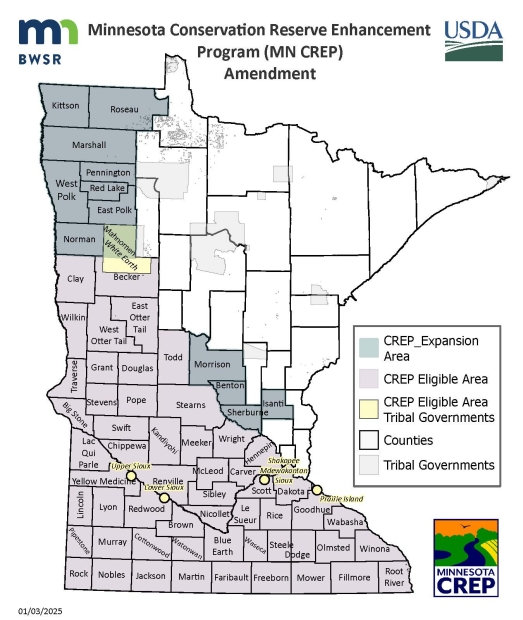The Minnesota Conservation Reserve Enhancement Program (MN CREP)
Update from May 16, 2025: The first batching period of calendar year 2025 will be held May 16 – June 6, 2025. Contact your local Soil and Water Conservation District for more information.
What is MN CREP?

The Minnesota Conservation Reserve Enhancement Program (CREP) is a partnership between the USDA and the Minnesota Board of Water and Soil Resources (BWSR) that provides voluntary conservation easement opportunities for landowners. CREP focuses on protecting environmentally sensitive land across 66 counties in southern and western Minnesota. Through this program, farmers and agricultural landowners receive payments to establish and maintain permanent conservation practices, ensuring long-term environmental benefits.
How it works:
- Landowners enroll in the federally funded Conservation Reserve Program (CRP) for 14-15 years.
- Administered by the USDA Farm Service Agency (FSA), CRP repurposes agricultural land for conservation rather than farming or ranching.
- The same land is also enrolled in a state-funded perpetual conservation easement through the Reinvest in Minnesota (RIM) Reserve program, managed by the Minnesota Board of Water and Soil Resources (BWSR).
- Landowners retain private ownership while the land is permanently restored and enhanced for conservation benefits.
MN CREP Objectives
The Minnesota CREP will protect up to 75,000 acres of the highest-priority areas across 66 counties by:
- Targeting riparian areas and marginal agricultural land for conservation.
- Restoring hydrology, improving water infiltration, and mitigating flood risks.
- Enhancing habitat for wildlife, pollinators, and non-game species.
- Reducing nitrate contamination in drinking water supplies.
How will the land be restored and protected?
MN CREP will focus on four main Conservation Practices (CPs) that have been identified through the federal CRP:
1. Grass Filter Strips (CRP CP 21)
2. Wetland Restoration - Non Floodplain (CRP CP 23a)
3. Wetland Restoration – Floodplain (CRP CP 23)
4. Native Grasses (Wellhead Protection Areas) (CRP CP 2)
5. Native Grasses (CRP CP2)
Why Enroll in MN CREP?
MN CREP offers long-term conservation benefits tailored to landowners’ goals. Key reasons to enroll include:
- Competitive Compensation – Landowners receive payments based on CRP rental rates (60% incentive above the standard CRP rate for a 14-15 year contract) and a lump-sum up-front payment for the permanent RIM easement, with rates based on local land values.
- Ownership Rights Retained – Landowners maintain ownership and control access for recreation and hunting.
- Profitable Use of Marginal Cropland – CREP targets lower-yielding, environmentally sensitive lands, such as previously drained wetlands and flood-prone riparian areas, with competitive payment rates.
- Improved Water Quality & Habitat – Enrolled lands enhance groundwater and surface water quality while providing habitat for pollinators and wildlife.
- Additional CREP Incentives – Landowners receive benefits beyond those offered by the Continuous Conservation Reserve Program (CCRP).
- Seamless CRP Re-Enrollment – Eligible lands currently in CRP may transition smoothly into MN CREP, ensuring continuous payments and preserving existing vegetation.
- Fully Funded Native Restoration – Restoration follows state and federal standards, using diverse native plant species at no cost to landowners. These restorations support both game and non-game wildlife.
Enrollment
Enrollment for the MN CREP began in May of 2017 and will continue until funds are exhausted or the 75,000 acre limit is reached.
